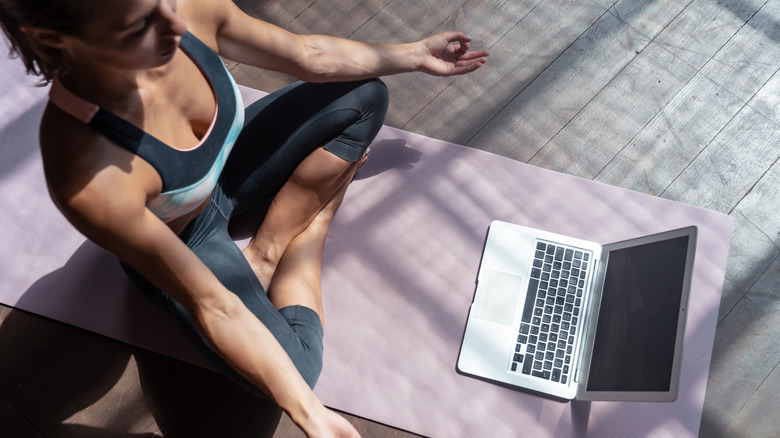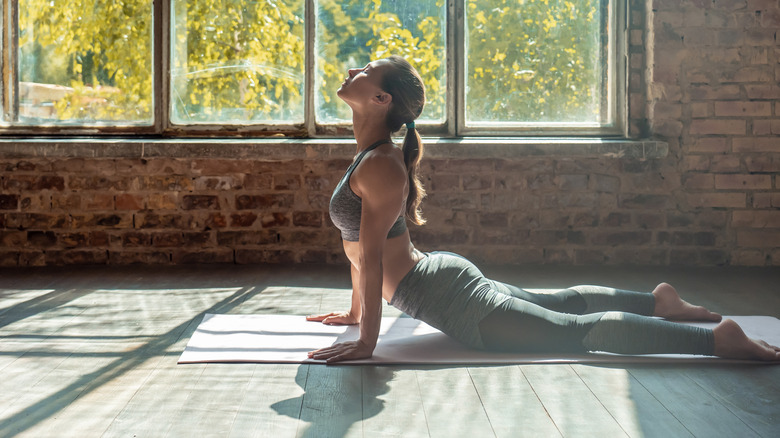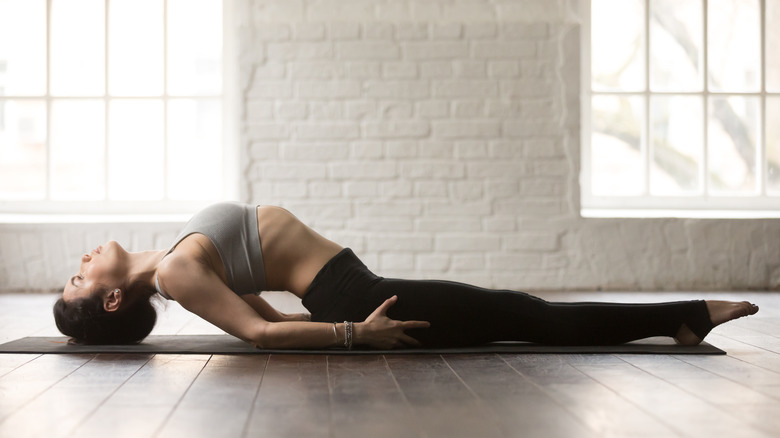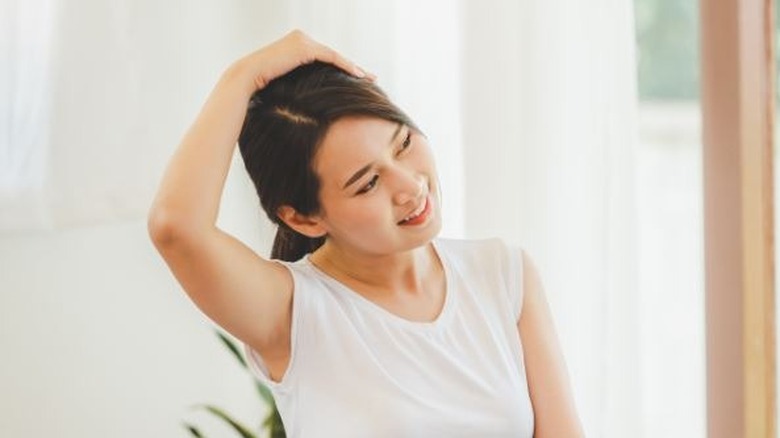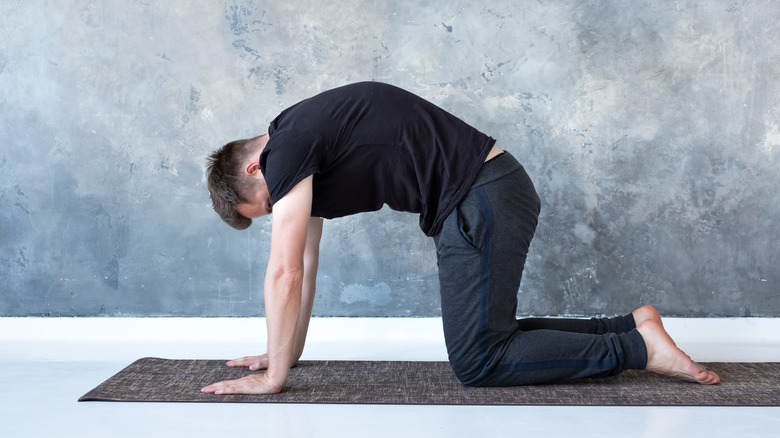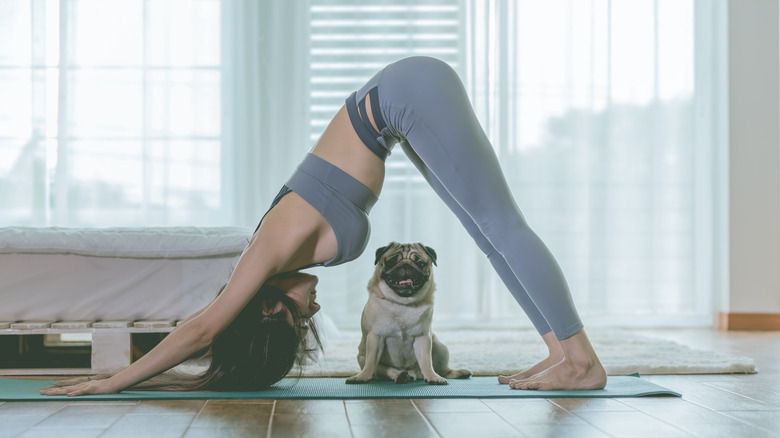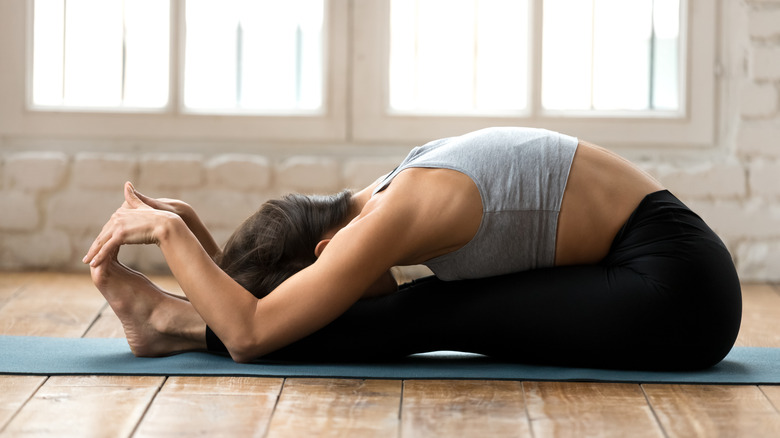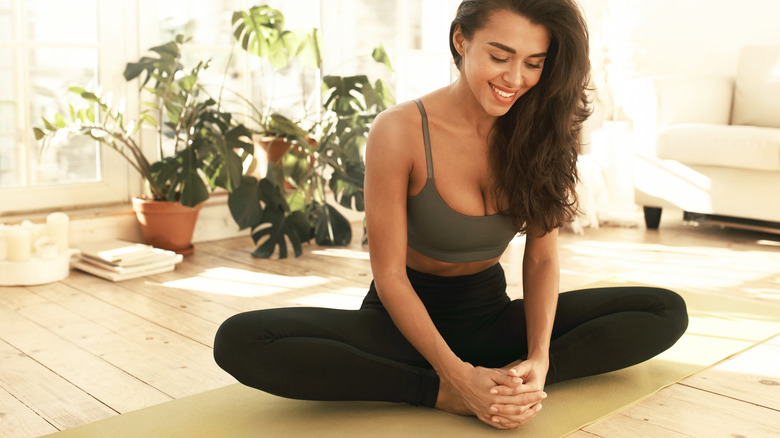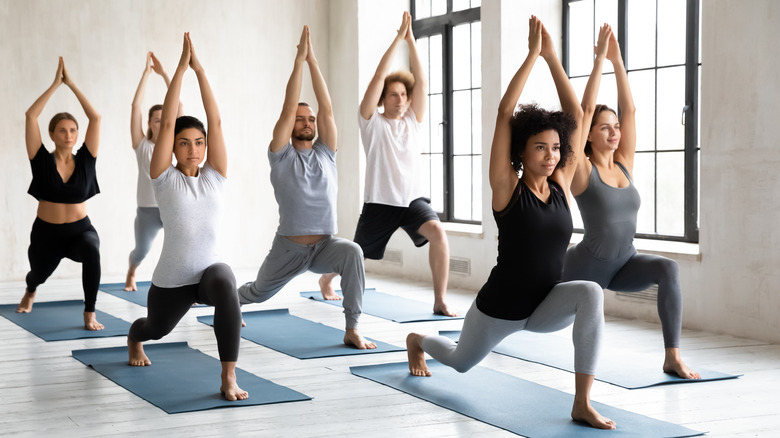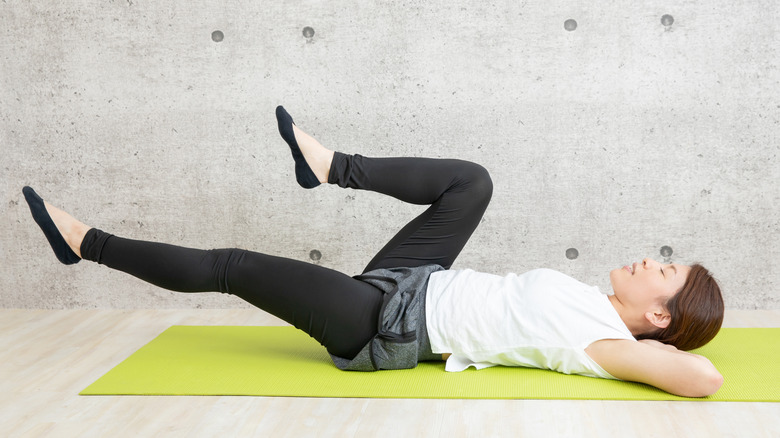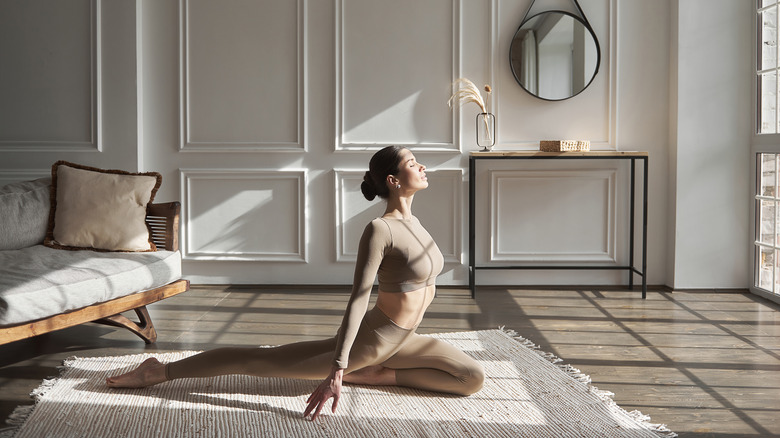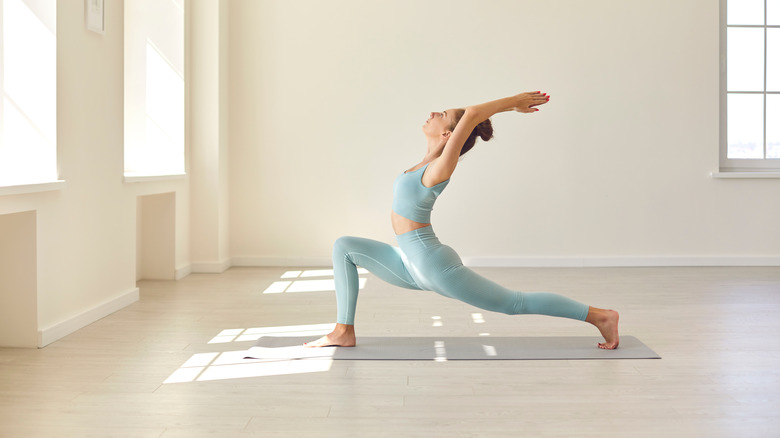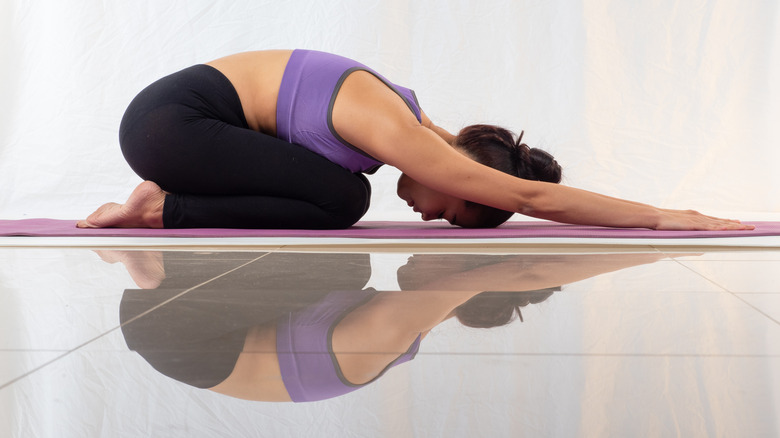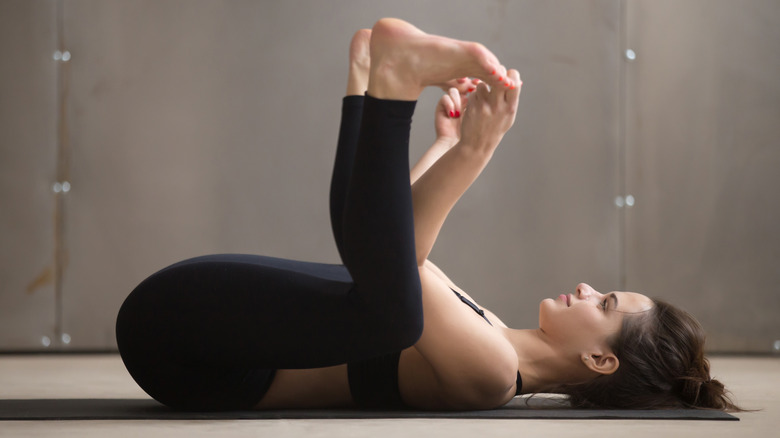The Best Yoga Poses For Pain Relief
The ancient practice of yoga has been used to alleviate aches and pains for centuries (via Journal of Pain Research). Research shows that for some people, yoga has the potential to manage chronic pain conditions like fibromyalgia. And its benefits may even outweigh the effectiveness of pain medication, says a study published in Annals of Internal Medicine. The researchers discovered that yoga can help reduce the need for pain drugs in patients with mild to moderate chronic lower back pain.
In recent years, studies have investigated yoga's effects on the brain. A study published in Frontiers in Human Neuroscience found differences between the brains of those with chronic pain and the brains of frequent yoga practitioners, suggesting that yoga may be both neurologically and physically protective. Whether you're yoga-ing to improve your alignment, strengthen your muscles, or simply relieve tension, here are some yoga poses that can help you target pain in different regions of the body.
Cobra (Bhujangasana)
The issue of shoulder pain has become almost ubiquitous in our modern times as the world shifts to the digital realm. "When we work from our laptops, we're mostly sitting in one place with our necks tilted forward", Rahul Chamoli, a registered yoga teacher with Yoga Alliance and founder of Aum Yoga Vietnam, told Health Digest. "This causes the muscles to become stiff. And since our shoulder muscles are connected to the neck through the trapezius muscle, this can result in shoulder pain over time".
Yoga can offset the damage of sitting down all day by helping you counteract slouching. Cobra, in particular, is an effective pose for shoulder pain. It helps opens up the chest and the front of the shoulders as well as strengthening the upper back muscles. "Many people do cobra with dropped shoulders but it's important remember to roll the shoulders back and down in order to relieve tension," explained Chamoli.
Fish pose (Matsyasana)
A regular yoga practice can do wonders in appeasing period cramps (medically termed primary dysmenorrhea). It can effectively treat PMS, premenstrual dysphoric disorder, and even polycystic ovary syndrome, which often leads to erratic or missed periods, according to a review study published in the Journal of Alternative and Complementary Medicine. The researchers found that certain asanas (including the reclined fish pose), pranayama (yogic breathwork), and yogic relaxation or meditation techniques were strongly associated with pain relief in women who faced monthly period-related woes. For some women, yoga helped relieve abdominal swelling and breast tenderness and brought some regularity to their menstrual cycles. It even had a positive effect on their mood and concentration.
Another study published in the Journal of Pediatric and Adolescent Gynecology discovered that a yoga intervention consisting of three postures (fish, cat, and cobra) helped reduce the severity and duration of women's menstrual pain. The fish is a reclined, back-bending pose that stretches and opens up the throat, chest, shoulders, and abdomen. It involves pressing the elbows and forearms against the floor as you lift the chest up to the sky, which can eliminate stiffness in the neck and shoulder muscles and improve spine flexibility. It's believed that yoga may help decrease pain by influencing the brain's pain center and stimulating the release of natural painkillers in the body. Awareness of breath also plays an important role in promoting relaxation and calmness.
Neck rotations
Neck rotation is a great stretch for any niggling neck, back, and shoulder-related issues. "It can loosen up, relax, and bring mobility to the neck", Rahul Chamoli, yoga teacher and founder of Aum Yoga Vietnam, told Health Digest. "A gentle neck stretch on both sides helps blood flow smoothly through your trapezius muscles, which are connected to our shoulder blades."
A 2019 study published in the journal Medicine showed that yoga consisting of neck rotations and flexions can curb neck pain. They were also found to improve cervical range of motion, pain-related function disability, quality of life, and mood.
Low-intensity neck exercises like rotations and flexions may also help get rid of headaches, reducing their intensity and frequency, reports a study published in the International Journal of Yoga. This is because yoga enhances vagal tone, decreasing your heart rate and blood pressure and increasing digestion. Yoga therapy could be incorporated as an adjuvant therapy in migraine patients, say the study authors. But it's important to make sure that these exercises are done mindfully and safely so as to avoid any potential injuries (via Tummee).
Cat/Cow (Marjaryasana)
Cat/cow, also known to yogis as Marjaryasana, is a great pose for postural awareness and spine alignment. "It works on both sides of the spine and helps to remove the blockage in our spine channels. This makes it a very good warm-up exercise for the spine," Rahul Chamoli, a registered yoga teacher with Yoga Alliance and founder of Aum Yoga Vietnam, told Health Digest. Cat/cow gently flows between two postures, opening up the chest and strengthening the back (via Yoga Journal).
Like many other yoga poses, practicing cat/cow can help remedy some of the aches and pains that build up from hours of sitting at your desk. Incorporating this pose into your yoga ritual may help undo that hunched-over appearance that develops over time when the chest and shoulder muscles get tight and overworked from working.
The cat pose in particular is a great asana for finding some sweet relief from menstrual pain, based on the findings of a study from the Journal of Pediatric and Adolescent Gynecology. This part of the posture involves pulling the belly in and rounding the spine upward while pressing the floor away. The cat helps link movement and breath, allowing you to cultivate a sense of balance and calm while increasing circulation throughout the body.
Downward-facing dog (Adho Mukha Svan)
The famous downward-facing dog, known in Sanskrit as adho mukha shvanasana, is a full-body stretch that's particularly good for lengthening the spine and hamstrings. Regularly practicing this asana can help reverse the outward curve of the upper back, Rahul Chamoli, a registered yoga teacher with Yoga Alliance and founder of Aum Yoga Vietnam, explained to Health Digest.
The exaggeration of this curvature is known as kyphosis, which can cause a great deal of pain, and in more severe cases, it might lead to breathing problems and fractures. A study from the Journal of the American Geriatrics Society showed that yoga was able to counter some of the adverse effects of kyphosis among senior women and men when practiced for three days a week over 24 weeks.
Downward-facing dog can also make the deep abdominal muscles stronger. In particular, this posture strengthens the external oblique abdominis, which are located on the lateral sides of the abdominal walls, notes a study published in the journal Complementary Therapies in Medicine. The researchers found that working on these areas is a great way to help rein in lower back pain.
Legs up the wall
This easy-to-do inversion asana has a number of therapeutic advantages (via Yoga Journal). Being a classic restorative pose, it can be used to help you relax and enter a state of calm, which makes it effective in aiding deep sleep. Lying on the floor with your legs resting against the wall stimulates your circulation, encouraging the blood to flow towards the heart and head. This activates the parasympathetic nervous system (the "rest and digest" side), which slows down your heart and respiration rate and lowers your blood pressure.
One of the many impressive benefits of this simple pose is that it can help relieve and manage some of the painful symptoms of sciatica (via Healthline). This often includes a sharp, shooting, or stabbing pain, or a burning sensation that radiates down one side of the body. Sciatica is a condition whereby the sciatic nerve becomes irritated and affected by inflammation of the surrounding tissue, resulting in pain in the lower half of the body, from the back all the way down to the toes.
Seated forward bend (Paschimottanasana)
The seated forward bend (Paschimottanasana) is a classic hatha yoga pose that gives the back of the body a satisfying stretch — from your spine to your hamstrings to your calves (via Verywell Health). It's an excellent stretch for runners who often struggle with tight, achy hamstrings. It also happens to be another go-to posture for relieving common menstrual problems, including premenstrual syndrome and cramps. Like many asanas, the seated forward bend is a calming pose that's been shown to bring down stress and anxiety and boost general psychological wellbeing, based on the findings of a study from the journal Anxiety, Stress & Coping.
"Seated forward bends help to remove the blockage in the muscles while also giving our organs a nice massage," Rahul Chamoli, a registered yoga teacher with Yoga Alliance and founder of Aum Yoga Vietnam, told Health Digest. He also noted that practitioners shouldn't forget to follow it up with a counter pose (like a gentle backbend) to extend the spine and reset the tailbone.
Butterfly pose (Baddha Konasana)
The playful butterfly, formerly known as Baddha Konasana in Sanskrit, is a seated pose that resembles a butterfly in motion (via Verywell Fit). It can also look a bit like a diamond shape as you bring the soles of the feet together and tuck them close to the groin, letting the knees fall out to the side.
Gently pressing the knees down opens up the hip flexors and inner thighs and offers the groin muscles a deep stretch. It can serve as both a pre and post-workout stretch for lower body activities like biking or running.
The butterfly is a particularly relieving for people who suffer from stiff hips and painful groins. A study published in the journal Pain Medicine reported that a yoga class that incorporated 12 postures, including the butterfly, helped women better manage their chronic pelvic pain: Participants who attended a twice-weekly class over six weeks saw substantial improvements in pain severity, as well as sexual function and general emotional well-being.
Warrior I (Virabhadrasana I)
Based on ancient Vedic teachings, the warrior is a powerful asana that was named after the legendary and mythic warrior Vīrabhadra (via Yoga Basics). Forming part of a series of five standing poses, warrior I entails bending the front knee and keeping the hips turned forward as the arms are raised up over the head.
Practicing the warrior can stretch, strengthen, and increase flexibility in the hips and groin. It can also strengthen and tone up the legs, ankles, and feet while engaging and building strength in your core. A bit like squatting, the warrior is a great posture for targeting any pain in the buttocks as it toughens up the gluteus maximum muscle, according to a study published in the journal Complementary Therapies in Medicine.
In a review study of older adults aged 60 and above, it was found that a yoga intervention featuring the warrior I pose enabled participants to improve their muscle strength, flexibility, and balance.
Cycling Pose Yoga (Pada Sanchalanasana)
Various yoga poses have been touted for their ability to ward off headaches. One of them is the cycling pose, which goes by the Sanskrit name Pada Sanchalanasana (via International Journal of Yoga).
There's evidence that yoga can help manage severe migraine headaches and improve patients' quality of life. A 2020 study showed that as a complementary therapy, yoga might even be more effective than medical treatment alone, and could serve as a safe way to treat migraines in the long-term (via Neurology).
The cycling pose also strengthens the knees, hips, core, and back, lowering your chances of pain or an injury in the future (via Tummee). It's recognized as part of the digestive group of asanas, which can help strengthen and improve the digestive system through engaging and activating the abdominal muscles. This is a great pose for people who are struggling with tummy troubles such as constipation, indigestion, bloating, and gas.
Pigeon pose (Kapotasana)
Known as the "king of hip openers", the pigeon is called Kapotasana in Sanskrit (via Yoga Journal). This popular pose works on stretching the hip flexors and lower back muscles, according to a 2019 study published in the International Journal of Yoga. The authors conclude that yoga can effectively curb hip and back pain by increasing flexibility and core strength. The muscles in these parts of the body tend to tighten up due to prolonged sitting, and the pigeon is particularly helpful in easing some of that built-up tension, making it another powerful posture for tackling "hunched-over laptop syndrome."
The pigeon is actually a variation of the one-legged king pigeon, or Eka Pada Rajakapotasana in Sanskrit (via Yoga Pose). This posture is known to support and aid digestion by gently stretching the lower abdominal region. Massaging the abdominal organs can stimulate the parasympathetic nervous system, reports a 2020 study from the journal Medicine. This has a number of therapeutic effects: It can reduce abdominal muscle tension and pain and relax the digestive sphincter muscles to promote bowel movements and help treat constipation.
Crescent Lunge (Anjaneyasana)
The crescent lunge, sometimes called the crescent pose, offers a beginner-friendly stretch for the hips, groins, and quadriceps (via Yoga Journal). It can also be used to stretch out the back muscles, if you want to go a little deeper into the pose.
Along with the warrior (Virabhadrasanaand) and tree (Vakrasana), the crescent lunge is a great pose for addressing hip problems, reports a study published in the International Journal of Yoga. In particular, the crescent lunge activates and stretches the hip flexors, quadriceps, and hamstrings. By working on these areas, this asana can be used as an effective counter-stretch for lower body workouts such as cycling and running, as well as for those lengthy hours sitting at a desk.
Research published in the Journal of Human Kinetics showed that lunge exercises in general can help build stability and balance throughout the body, which can be used to prevent injuries and future aches and pains.
Child's pose (Bal Asana)
This gentle beginner pose has a multitude of benefits. It can help give your spine a calm stretch, Rahul Chamoli, a registered yoga teacher with Yoga Alliance and founder of Aum Yoga Vietnam, told HealthDigest. At the same time, the child's pose soothes the nervous system, which makes it a potent practice for cultivating calmness in both the morning and at bedtime. To enhance its stress-relieving effects, concentrate on breathing slowly and deeply while holding the posture for a few minutes.
Regularly practicing the child's pose can help smooth out pain in the lower back and promote circulation to the muscles, joints, and discs of the back (via Verywell Health). It can also work on opening the hips and stretching the inner thighs. A wide child's pose is another posture that can help ease menstrual cramps and aid pain relief around the abdomen, according to a study from the Journal of Alternative and Complementary Medicine. Try to widen your knees farther apart than you normally would when holding this pose.
Happy baby (Ananda Balasana)
Much like the name suggests, this energizing pose resembles a happy baby rocking back and forth on its back. This tension-releasing asana feels good for the entire body, as it opens up the hips while giving your back a gentle massage (via Verywell Fit). It's a quick and simple way to release emotions, let go of stress, and elevate your mood. Practicing this consistently may help you beat fatigue and anxiety.
This is also a great stretch for your lower back, inner groin, hamstrings and inner thighs. It works on relieving tightness and pain around the lower part of the body, and helps supports mobility and flexibility in the glutes and hip joints. The happy baby is a favorite among people who spend long periods of time sitting down, or those who have an injury from a lower body exercise like cycling or sprinting. To get the most out of this pose, make sure that you keep your shoulders raised and chin lifted.

